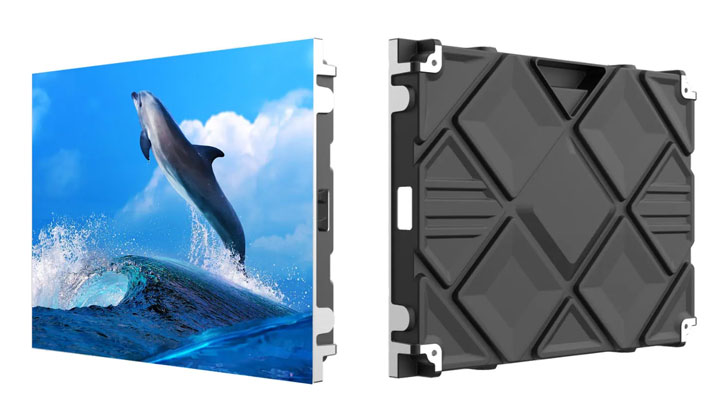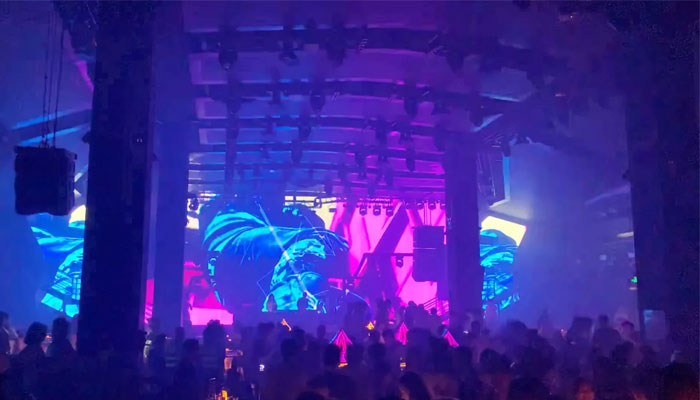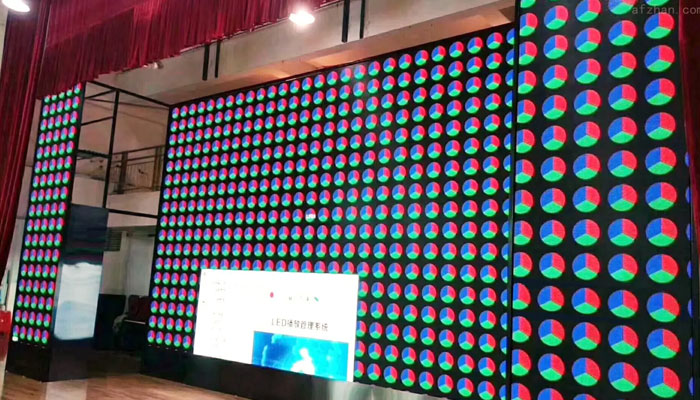With the development of the society and the gradual improvement of the visual level, the LED display screen gradually appeared in the public’s field of vision and was recognized by the users. From the red and green primary color LED display screen to the later full-color display screen A certain industrial scale and form have been formed. With the popularization and promotion of the Internet, the application space of LED display screens in the process of informatization is also gradually expanding, showing a good development situation.

When shopping in the mall, you will often see a lot of indoor small-pitch LED displays, which are widely used to promote products or guide services. In the conference room, LED displays are often used to display the content of the explanation.
Although LED displays are very common indoors now, many people still don’t know how to choose indoor LED displays? Next, I will give you the popularization of the selection of indoor led display methods.
There are many models of indoor LED displays, so what kind of display is suitable for your own use?
First of all, everyone has a subconscious about the large LED screen. The high-definition LED display is the best, and the high-brightness LED display is also the best. Is this view correct?
Our answer is that this is the best choice for your needs. We recommend that when users choose an indoor LED display, they must first determine the size of the width and height, and then look at the distance at which they are generally viewed. These two points are the most important, and then determine what our budget is. .
The specifications of the LED display are mainly classified according to the pixel pitch of the LED display. For example, the distance between two pixels is 3mm, the P3 model is 3mm, and so on, the P2 is 2mm. Therefore, the point spacing is different, and the number of pixels in each square meter is different, so our sharpness is also different. The smaller the dot density, the more unit pixels, and the higher the definition of the picture. Therefore, when choosing a display screen, we have to choose the corresponding specifications according to our screen needs.
How to install the display? How to choose the right model?
A, Arrangement: The size of the LED display screen is selected according to the use site. For example, when installing a wall-mounted LED display or embedded LED display, you must first determine the size of the wall, select a suitable location, and then determine the size of the width and height required for the display.
B. Model selection: Similarly, it is necessary to determine the viewing distance. The easiest way is to select the appropriate size and brightness according to the viewing distance on site. Taking P1.25 as an example, the best viewing distance is 1.25 meters away, and the best viewing distance of P1.9 is 1.9 meters away. the best viewing distance. In this way, when choosing an indoor LED display model, the approximate viewing distance must be estimated, so that we can estimate and select the most suitable specification model. Similarly, the higher the brightness, the better. In the case of close range, too high brightness will also irritate the eyes, so the viewing distance should also be considered to select the appropriate display brightness.
Finally, it is necessary to choose according to the use environment of the display screen. Is the LED display installed in the hall? Still installed in the conference room, or on the stage; fixed installation, still need mobile installation, etc. These are the questions we need to consider when customizing the LED display.
Of course, the most important point is that you need to choose a suitable LED display according to your own budget. The prices of different manufacturers and different specifications of the display are different. You can make a reasonable choice according to your own budget.

What is a small pitch LED display?
It is a direct-view LED display, called version 2.0. You are already familiar with LED screens for large installations, fine pitch LED displays use a similar type of technology, but better. LEDs create the magic you want to display great content in these LEDs, similar to looking straight at an LED display, small pitch gives you more fun and higher quality, what the heck is this technology? To be precise, light-emitting diodes are small semiconductors. They will convert electricity into light. Each diode contains a specific chemical that produces blue, green, or red, creating colorful images that look lifelike. There is a set of blue, green and red LEDs that together create a colored pixel.
This is where the magic happens when we talk about fine pitch LED displays. More pixels means better digital signage displays, such as images or videos. When someone is close to the screen, the content looks amazing. Mainly the small pitch display is to display the pitch in millimeters. The pixel pitch of the small-pitch LED display is extremely small. Because the pixels are so close together on the screen, we have more pixels. As a result, the resolution of the screen will be higher. This means that even when you’re viewing the screen from very close, the picture quality is excellent. So you can imagine how stunning your signage content can be.
How to choose between small pitch LED and traditional LED screen?
It all depends on your use case, and it’s important to know because you don’t need to be very close when viewing the scene. You can opt for LED displays with larger pixel pitch, for example, huge digital signage in places like Times Square or stadiums, you can use traditional LED screens as these installations do not require higher resolution, the reason behind this is No one will be viewing these displays from too close. Therefore, you can consider using a traditional LED display in this case. Remember that the cost of a fine pitch LED display will be much higher than that of a traditional LED display, so you must make sure it is suitable for your use case. Likewise, for a student-focused college campus, you don’t need a fine-pixel display because students walking around won’t be looking at the screen too closely.
How to determine display spacing for your project?
Surprisingly, different manufacturers use different methods to calculate the pixel pitch required by customers at different viewing distances. The range is huge, from 0.8mm ultra-fine pitch LEDs up to 16mm. The monitor you need depends on how far the viewer is viewing the screen. A popular way to calculate pixel pitch based on viewing space is that you should multiply the pixel pitch by 3 to get the viewing space in meters, so if the viewing space is about 6 meters, you need a 2mm pixel pitch. Another reliable way to calculate pixel spacing is to rely on the viewing space of the retina. If you have 20/20 vision, the ideal way is to calculate the pixels by multiplying each millimeter by 10. That means for a millimeter pixel pitch, you get ten feet. Most pixel pitch LED screens start at 1.5mm. However, you can lower or lower depending on your budget.
Compared with traditional LED displays, do small-pitch LED displays have advantages?
The price of small-pitch LED displays is higher than that of traditional LED displays. So there has to be something that makes fine pitch LED displays more expensive. First, fine-pitch LEDs have higher screen resolutions and excellent image quality. These displays don’t have the noticeably blocky pixels we usually notice in traditional LED displays. Other additional benefits of fine pitch LED displays include better brightness, smooth bezel-less video walls, and energy efficiency. Your shows, codes, videos and images will look amazing. It takes digital signage content to a whole new level. Even if someone is watching your video content from a few feet away, the display quality will be amazing.
Remember, the high contrast and extra brightness mean you can have this type of display anywhere. Whether outdoors or indoors, no matter what your ambient light is, you’ll find your LED display works just fine. In addition, these displays are available in a variety of sizes, so you have the luxury of deploying any electronic signage you need. If you need top-notch display quality from a few feet away, you should choose these displays.
Small interval applications are more flexible
The application of small LED display products is also more flexible, and can be combined with ultra-popular elements such as touch screen, naked-eye 3D, 4K, etc. to meet more diverse application needs. At present, small-pitch LED display products are still the first choice in the high-end indoor display field, which is more in line with the needs of consumers in terms of technology and application. Therefore, small-pitch LED screens will continue to be the general trend in the future.
The dot pitch of the LED display is getting smaller and smaller, and the application field is getting wider and wider. In addition to the conventional SMD package, now the cob package is gradually entering the user’s choice. Users have more choices, and it is more difficult to distinguish the data. Let’s take a look at the key parameters of the LED small-pitch screen, so that we can quickly understand in the selection.
In the case of different requirements of led display projects, several parameters of led display are fixed: dot pitch, resolution, packaging method, flatness, frame change frequency, refresh rate, contrast, brightness, gray level, average power consumption and lifespan.
The dot pitch is directly linked to the price. The smaller the dot pitch, the higher the resolution, the clearer the display and the higher the price.
Then there is the packaging method. The current mainstream packaging methods are cob and smd. The cob packaging will be marked in the bidding. The cob package encapsulates the chip on the PCB board, will not drop the light, has higher stability, and saves a lot of manufacturing processes, and can make the dot pitch smaller.
Flatness, frame rate, refresh, contrast, brightness, and grayscale are all effects that directly affect the screen display. The higher the contrast, grayscale, refresh, and frame rate, the higher the frame rate, and the smaller the flatness, the better the effect. Brightness depends on demand. Generally, it should not be too high for indoor use.
The above are several key parameters that can be focused on when choosing a small LED pitch. The LED small-pitch screen is characterized by small dot spacing and high display resolution, which improves the clarity of the entire screen. For the use of large indoor screens, multi-signal access can show the power of LEDs at this time.




